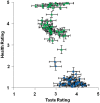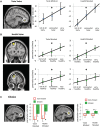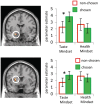Taking a different perspective: mindset influences neural regions that represent value and choice
- PMID: 21972426
- PMCID: PMC3475361
- DOI: 10.1093/scan/nsr062
Taking a different perspective: mindset influences neural regions that represent value and choice
Abstract
Most choices are complex and can be considered from a number of different perspectives. For example, someone choosing a snack may have taste, health, cost or any number of factors at the forefront of their mind. Although previous research has examined neural systems related to value and choice, very little is known about how mindset influences these systems. In the current study, participants were primed with Health or Taste while they made decisions about snack foods. Some neural regions showed consistent associations with value and choice across Health or Taste mindsets. Regardless of mindset, medial orbitofrontal cortex (MOFC) tracked value in terms of taste, regions in left lateral prefrontal cortex (LPFC) tracked value in terms of health, and MOFC and dorsal anterior cingulate were associated with choice. However, activity in other neural regions was modulated by the mindset manipulation. When primed with Taste, rostral anterior cingulate tracked value in terms of taste whereas left amygdala and left putamen were associated with choice. When primed with Health, right LPFC and posterior MOFC tracked value in terms of health. The findings contribute to the neural research on decision-making by demonstrating that changing perspectives can modulate value- and choice-related neural activity.
Figures






References
-
- Birch LL. Development of food preferences. Annual Reviews Nutrition. 1999;19:41–62. - PubMed

